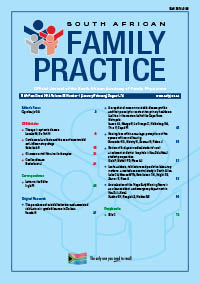Lactic acidosis, risk factors and predictive laboratory markers: a nested case control study in South Africa
Keywords:
lactic acidosis, stavudine, antiretroviral, toxicity, human immunodeficiency virus
Abstract
Background: The incidence of antiretroviral therapy (ART)-induced lactic acidosis and its associated mortality may be reduced by appropriate dosing, risk stratification and early detection. Objectives: To describe the epidemiology of lactic acidosis, define the risk factors and identify predictive laboratory markers in the context of the roll-out of ART in South Africa. Design: A nested case control study. Risk factor analysis was adjusted for the established risk factors of weight and gender. Setting and subjects: Persons commenced on stavudine-containing therapy between 2004 and 2007 at Port Shepstone Hospital in KwaZulu-Natal were included. Persons with a body weight above 60 kg received Stavudine 40 mg twice daily, and those with a body weight below 60 kg, 30 mg twice daily. Outcome measures: Assessed risk factors included weight, gender, age, alanine transaminase (ALT), urea, creatinine, albumin, cholesterol, triglyceride (TG) levels, CD4 counts and viral loads. Results: Lactic acidosis occurred in 79 (17 per 1 000 person-years) of 1 762 people living with HIV on ART. Significant factors were being female [adjusted odds ratio (AOR) of 5.4] and increased body weight (adjusted OR of 1.1 per kg). The risk of lactic acidosis increased 6.6, 6.9 and 95 times (adjusted ORs) as weight increased from a baseline weight of < 60 kg to 60-69 kg, 70-79 kg or > 80 kg, respectively. Six months into therapy, predictors of developing lactic acidosis were an ALT > 50 IU/l (adjusted OR of 11.1) and a higher TG (adjusted OR of 8.8 per mmol/l). No associations were found with regard to age, CD4 count, viral load, and creatinine or albumin levels. Conclusion: Obese females are at greatest risk of lactic acidosis, with an exponential increase in risk above 80 kg. The 30-mg dose may be preferable, given that a sharp increase in risk occurred at 60 kg, was most likely dose related, and that 30 mg has been shown to provide adequate virological suppression. Additional risk factors for lactic acidosis include a high ALT and TG levels at treatment.
Published
2013-08-01
Section
Original Research
By submitting manuscripts to SAFP, authors of original articles are assigning copyright to the South African Academy of Family Physicians. Copyright of review articles are assigned to the Publisher, Medpharm Publications (Pty) Ltd, unless otherwise specified. Authors may use their own work after publication without written permission, provided they acknowledge the original source. Individuals and academic institutions may freely copy and distribute articles published in SAFP for educational and research purposes without obtaining permission.

